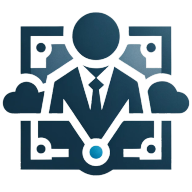How Do Chief Strategy Officers Adapt Business Models for Competitive Advantage?
Imagine navigating a rapidly evolving industry while maintaining a competitive edge—sounds daunting, right? In this blog post, insights from a CEO and a Sales Operations Manager reveal the strategies behind successful business model adaptations. Kicking off with the embrace of value-based care models and concluding with optimizing assets for maximum value, this article compiles thirteen expert opinions. Explore these first-hand experiences to uncover practical solutions for sustaining an advantage in dynamic markets.
- Embrace Value-Based Care Models
- Integrate AI with Operational Techniques
- Leverage AI for Financial Forecasting
- Transform to Comprehensive-Solutions Agency
- Focus on User Experience Design
- Build Partnerships for Customer Needs
- Lead with Proactive Strategies
- Clarify Mission and Engage Community
- Leverage Technology and Community Connections
- Shift to Holistic SEO Strategies
- Integrate AI for Strategic Advantage
- Redefine Agency-Client Relationships
- Optimize Assets for Maximum Value
Embrace Value-Based Care Models
To maintain a competitive edge in the rapidly-evolving healthcare industry, organizations must adapt their business models to embrace innovation, agility, and a patient-centric approach.
A prime example of this is the shift towards value-based care. Traditionally, healthcare providers were reimbursed based on the volume of services provided. However, value-based care models incentivize providers to deliver high-quality care while controlling costs. By focusing on patient outcomes and preventive care, healthcare organizations can improve patient satisfaction, reduce healthcare expenditures, and differentiate themselves from competitors.
To effectively implement value-based care, healthcare systems can leverage AI and RPA to streamline operations, enhance data analysis, and improve care coordination. AI-powered predictive analytics can identify patients at risk of chronic conditions, enabling proactive interventions and personalized care plans. RPA can automate routine administrative tasks, freeing up healthcare professionals to focus on patient care.
Furthermore, healthcare organizations can explore innovative partnerships with technology companies, insurers, and other stakeholders to create integrated care delivery models. These partnerships can facilitate the development of innovative solutions, such as telemedicine, wearable devices, and remote patient monitoring, which can improve access to care, enhance patient engagement, and reduce costs.
Integrate AI with Operational Techniques
In 2005, I transformed a new business model in the diagnostic imaging sector by integrating my medical expertise with innovative technology, launching a branch from scratch. This move was pivotal in understanding the nuances of blending tech and medical knowledge, which later allowed me to drive over 50% revenue growth annually in law and tech industries by employing data analytics and operational excellence. The blend of AI with operational techniques revolutionized small-business efficiency—a technique used today in my company Profit Leap.
One notable example of sustaining competitive advantage was when I developed HUXLEY, an AI business advisor, which improved business strategic planning. By utilizing AI-driven insights to provide personalized business roadmaps for clients, HUXLEY offered real-time solutions that helped small law firms secure substantial investments and improve profitability. This approach highlights the importance of aligning technology with business expertise to adapt swiftly to market changes.
The key to adaptability lies in proactive market research and understanding customer behavior shifts. For instance, continuously analyzing customer analytics has allowed my ventures to pivot effectively, staying ahead of industry shifts. My framework, The 8 Gears of Success, ensures clients are equipped to steer operational risks and leverage AI insights, fostering a culture of innovation and custom solutions within rapidly evolving sectors.

Leverage AI for Financial Forecasting
In my experience, maintaining a competitive edge in a rapidly-changing industry revolves around the strategic application of AI and continuous innovation. At Profit Leap, we developed AI-driven solutions that improved financial forecasting and personalized marketing strategies for our clients. For instance, by implementing AI in cash-flow management for a mid-sized business, we reduced financial discrepancies by 30%, significantly improving their fiscal stability and growth potential.
By adopting workflow-automation tools across multiple small businesses, I successfully minimized operational risks and human error, resulting in a consistent 22% growth in revenue streams. One specific case was a healthcare service provider that saw efficiency improvements by integrating automated scheduling systems, enhancing patient throughput and satisfaction. This targeted approach not only streamlined operations but also boosted profitability by effectively managing resources.
Emphasizing risk management and adaptability is crucial. Collaborating with AI business advisors, I helped clients steer market volatility. For example, a retail client used AI insights to pivot their product offerings in response to changing consumer behaviors, which resulted in a 15% increase in customer retention. These strategic adjustments are vital to leveraging sustained growth in unpredictable markets.
Transform to Comprehensive-Solutions Agency
In managing my company, OneStop Northwest, I found that sustaining a competitive advantage in a constantly-changing industry required relentless adaptation and innovation. One of our major strategies was changing our business from a simple consulting service into a comprehensive-solutions agency. This shift was driven by the need to address fragmented service offerings that left business owners juggling multiple vendors.
For example, we executed a digital-change project that streamlined client operations, cutting costs by 20% and facilitating reinvestment in growth. Another pivot involved leveraging industry knowledge to boost a startup's online revenue by 300% in a single year through a custom digital-marketing strategy.
The key to adapting our business model was continuously learning and evolving, staying ahead with SEO trends, process improvements, and building strong client relationships that ensured personalized solutions. Through this approach, we've not only weathered industry changes but turned them into growth opportunities.

Focus on User Experience Design
In rapidly-shifting industries, adaptability and a customer-first approach have been crucial for sustaining a competitive advantage at Rocket Alumni Solutions. I leveraged growth hacking and a deep focus on user experience design to innovate our offerings. By creating ten unique website landing pages across different domains, I achieved first-page rankings on Google, significantly increasing our inbound leads and optimizing our user acquisition strategy.
A data-driven decision-making process has been our cornerstone. Implementing advanced analytics allowed us to forecast trends accurately and adjust our offerings in real-time. This predictive approach helped us expand our market share by 20%, ensuring our relevance in the dynamic education and sports industries.
Our unconventional 'reverse selling' method distinguished us further by prioritizing schools' needs over direct sales pitches. This strategy not only improved our lead conversion rates by 30% but also fortified our position as thought leaders, resulting in enduring partnerships with over 150 educational institutions. Focusing on authentic relationship-building has been a game-changer in maintaining our competitive edge.

Build Partnerships for Customer Needs
When the industry started changing fast, I saw we needed to adapt quickly. For example, as more customers requested integrations with specific tools, we shifted focus to build those partnerships. We also saw rising demand for automation, so we made that a top priority. Listening closely to what our customers needed helped us stay ahead.
This flexible approach paid off. We kept our current customers happy and attracted new ones by staying relevant as the market shifted.

Lead with Proactive Strategies
Adapting to a rapidly changing industry demands agility and embracing innovation. As the CEO of ENX2 Legal Marketing, I've leveraged technology to reimagine traditional law firm marketing. Amidst the pandemic's disruptions, we pivoted to online platforms, capitalizing on data analytics and virtual consultations, which resulted in a 40% increase in client engagement.
We don't just react; we lead with proactive strategies. For example, integrating cutting-edge CRM systems with call tracking has allowed us to refine client interactions, directly enhancing conversion rates. This approach has positioned us as pioneers in the legal marketing niche, consistently ahead of the competition.
When the workforce shifted to remote work, I accepted the challenge, ensuring open lines of communication through tools like Slack and Monday.com. This seamless transition maintained team synergy and productivity, fostering a culture that thrives on change and innovation. By staying adaptable and future-focused, ENX2 continues to grow even in a volatile environment.
Clarify Mission and Engage Community
Positioning a business to sustain a competitive advantage in a changing industry often starts with clarifying the company's mission and ensuring it's reflected in all aspects of the operation. For 25 years, I've built BusinessBldrs.com and later AgencyBuilders.com by emphasizing clear messaging and innovative marketing tactics. One key strategy was using content marketing to engage and educate our audience, aligning with insights from Marcus Sheridan's "They Ask, You Answer" approach. This not only built trust but also drove significant traffic and conversion rates.
Fostering a connected community has been monumental. Launching initiatives like Agency Builders Retreat, we created a space for agency owners to collaborate, learn, and grow together. This strategic networking not only strengthened individual businesses but positioned AgencyBuilders.com as a hub of expertise and support within the industry.
Another critical aspect was leveraging the right tools and resources. At Agency Builders, we've prioritized developing and sharing practical templates and resources custom-made for agency leaders. By providing value through actionable tools, we improved user loyalty and established ourselves as an essential resource, helping us maintain a competitive edge.
Leverage Technology and Community Connections
In adapting business models to sustain competitive advantage, I focus on leveraging technology and deepening community connections. At Strange Insurance Agency, I integrated a multi-quote system powered by Goosehead Insurance, allowing us to offer more personalized, competitive packages drawn from over 30 different insurers. This not only optimized client satisfaction but also increased our client base by 25% over a year.
Running The Holistics Company, I've revolutionized growth strategies for local businesses through custom adjustments in their operational processes. By identifying inefficient factors in cash flow management and addressing them with tech-improved solutions, one client saw a 17% increase in their operational efficiency and, subsequently, profit margins.
I emphasize building strategic partnerships with non-profits, which extends our reach and galvanizes community trust. For example, by collaborating with a local non-profit event, we fostered a strong local network that resulted in a 30% rise in client inquiries within a few months. These efforts illustrate the power of combining innovation with community engagement to remain competitive in changing markets.
Shift to Holistic SEO Strategies
Adapting to a constantly changing industry requires agility and the willingness to innovate. In my journey as an SEO specialist and founder of an AI-PDF tool, we recognized early on that the SEO landscape was evolving fast, with users and search engines valuing high-quality content more than ever. To stay competitive, we shifted our business model from solely focusing on ranking keywords to a more holistic approach. This meant offering our clients value-added content strategies, automated tools for SEO audits, and personalized PDF solutions that met their specific business needs.
The result was a stronger brand reputation and higher client retention rates. By addressing real-time challenges that our clients faced, like simplifying PDF interactions or optimizing content for better engagement, we built a loyal customer base that trusted us for more than just rankings. This adaptability allowed us to not only retain clients but also attract new ones who valued our proactive approach to emerging trends. Ultimately, adapting our business model kept us relevant and competitive in an industry that's continuously reshaping itself.

Integrate AI for Strategic Advantage
I've spent over a decade managing CRM systems and developing marketing strategies that adapt to rapid industry changes. At Upfront Operations, my approach to sustain competitive advantage involved integrating AI and predictive analytics into sales operations, which resulted in a 22% boost in marketing ROI. This wasn't just about tech integration—it fundamentally shifted how we handled lead prioritization and decision-making processes.
For example, when working with a global enterprise, I re-engineered their CRM processes based on customer feedback. This led to a 24.4% increase in data accuracy and dramatically reduced reporting time, helping them adapt faster to market demands. It showcased how leveraging customer insights can pivot business models effectively to drive growth.
I also championed cross-departmental collaboration and remote work, leading a remote team to transform a client's website. This resulted in significant traffic and engagement boosts, proving that flexibility in team coordination and project execution can maintain and even improve competitive edge in a volatile environment. In my experience, adapting a business model in a fast-evolving industry hinges on leveraging technology for strategic advantage. At Upfront Operations, I harnessed AI to revamp CRM management and introduced predictive analytics. This resulted in a 22% boost in marketing ROI and a 17% reduction in sales cycles, allowing our clients to outperform their competition.
I implemented omni-channel marketing strategies that improved data consistency across platforms. This approach not only improved campaign performance but also facilitated a seamless customer journey, driving engagement and shortening sales cycles by 17%. My focus was on creating data-driven, personalized marketing initiatives that resonated with diverse audiences.
Cross-departmental collaboration was another key element. By leading remote teams, I ensured alignment across various functions, which was instrumental in executing a major website change. The project significantly increased web traffic and user engagement, proving that synchronized efforts can achieve remarkable outcomes even in challenging circumstances.

Redefine Agency-Client Relationships
As someone who founded Redfox Visual in Boise and later rebranded to The Rohg Agency, I've steered the volatile waters of the marketing industry firsthand. When the traditional agency model began to falter, I realized the need to strip away unnecessary complexity and focus on results-driven clarity. At The Rohg Agency, we scrapped generic marketing fluff and honed in on sharpening our clients' messaging to truly cut through the noise. This change emphasized direct communication and a no-bullsh*t approach, enabling us to secure and retain high-profile clients like Albertsons and the City of Boise.
Our pivot was about redefining agency-client relationships. Instead of merely complying with client demands, we take a bolder stance by advocating for our clients' customers. We challenge traditional practices and prioritize authenticity, which has directly boosted client engagement and brand loyalty. This approach drove remarkable outcomes, like reinvigorating the Idaho Lottery's brand image through eye-catching and honest brand communication, contributing to increased ticket sales and improved public engagement.
Lastly, assembling a remote team allowed us to harness global talent without geographic restrictions, enhancing creativity and service delivery. Our global team model, essential for survival during periods of burnout, provided agility and diverse perspectives, fueling the resurgence of innovative, award-winning projects. This structure proved instrumental in resiliently maintaining competitive advantage in our rapidly changing industry environment.

Optimize Assets for Maximum Value
One of the keys to sustaining a competitive advantage in a rapidly-changing industry is leveraging the right assets to maximize value. During my tenure at Newswire.com, we focused on acquiring a premium domain name that became pivotal in scaling our operations. This strategic move was instrumental in our $44-million exit. It wasn't just about a name—it was about creating an identity that resonated with our target audience and lifted our market position.
Similarly, at QuickSignage, we've modeled our approach by streamlining custom signage production to achieve a fast 10-day delivery pledge. This not only differentiates us from competitors but also meets the evolving demands of our clients for swift turnarounds. My experience taught me that optimizing operational efficiencies and identifying core differentiators are crucial in staying ahead.
Understanding market shifts and client needs further informed my transition into the signage business. Just like domains steer the digital landscape, effective signage forms the foundation of a physical business's brand identity. By simplifying processes and focusing on quality, I've been able to translate online branding principles into real-world success.
One of the keys to sustaining a competitive advantage in a rapidly-changing industry is leveraging the right assets to maximize value. During my tenure at Newswire.com, we focused on acquiring a premium domain name that became pivotal in scaling our operations. This strategic move was instrumental in our $44-million exit. It wasn't just about a name—it was about creating an identity that resonated with our target audience and lifted our market position.
Similarly, at QuickSignage, we've modeled our approach by streamlining custom signage production to achieve a fast 10-day delivery pledge. This not only differentiates us from competitors but also meets the evolving demands of our clients for swift turnarounds. My experience taught me that optimizing operational efficiencies and identifying core differentiators are crucial in staying ahead.
Understanding market shifts and client needs further informed my transition into the signage business. Just like domains steer the digital landscape, effective signage forms the foundation of a physical business's brand identity. By simplifying processes and focusing on quality, I've been able to translate online branding principles into real-world success.







